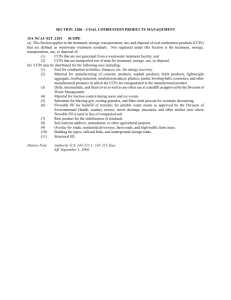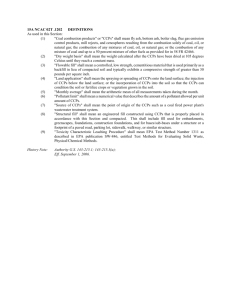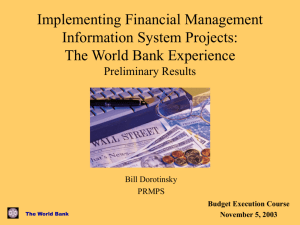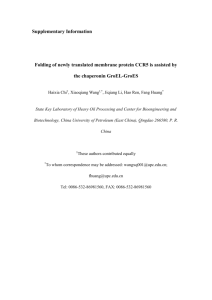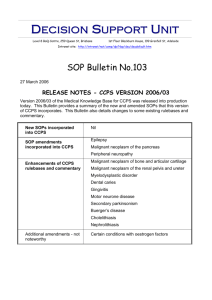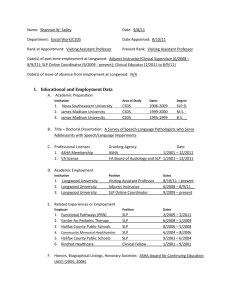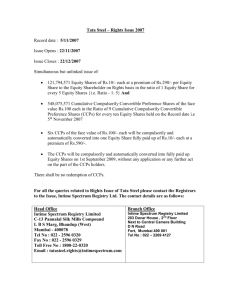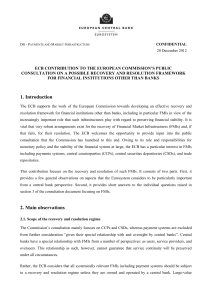Austrian Federal Ministry of Finance
advertisement
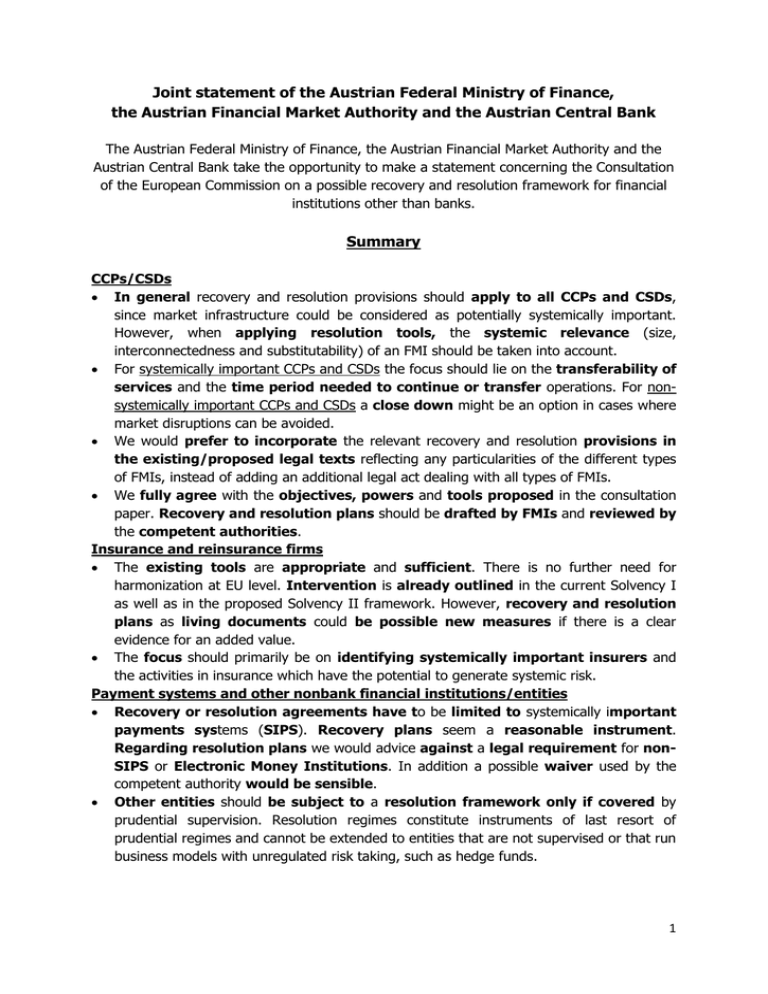
Joint statement of the Austrian Federal Ministry of Finance, the Austrian Financial Market Authority and the Austrian Central Bank The Austrian Federal Ministry of Finance, the Austrian Financial Market Authority and the Austrian Central Bank take the opportunity to make a statement concerning the Consultation of the European Commission on a possible recovery and resolution framework for financial institutions other than banks. Summary CCPs/CSDs In general recovery and resolution provisions should apply to all CCPs and CSDs, since market infrastructure could be considered as potentially systemically important. However, when applying resolution tools, the systemic relevance (size, interconnectedness and substitutability) of an FMI should be taken into account. For systemically important CCPs and CSDs the focus should lie on the transferability of services and the time period needed to continue or transfer operations. For nonsystemically important CCPs and CSDs a close down might be an option in cases where market disruptions can be avoided. We would prefer to incorporate the relevant recovery and resolution provisions in the existing/proposed legal texts reflecting any particularities of the different types of FMIs, instead of adding an additional legal act dealing with all types of FMIs. We fully agree with the objectives, powers and tools proposed in the consultation paper. Recovery and resolution plans should be drafted by FMIs and reviewed by the competent authorities. Insurance and reinsurance firms The existing tools are appropriate and sufficient. There is no further need for harmonization at EU level. Intervention is already outlined in the current Solvency I as well as in the proposed Solvency II framework. However, recovery and resolution plans as living documents could be possible new measures if there is a clear evidence for an added value. The focus should primarily be on identifying systemically important insurers and the activities in insurance which have the potential to generate systemic risk. Payment systems and other nonbank financial institutions/entities Recovery or resolution agreements have to be limited to systemically important payments systems (SIPS). Recovery plans seem a reasonable instrument. Regarding resolution plans we would advice against a legal requirement for nonSIPS or Electronic Money Institutions. In addition a possible waiver used by the competent authority would be sensible. Other entities should be subject to a resolution framework only if covered by prudential supervision. Resolution regimes constitute instruments of last resort of prudential regimes and cannot be extended to entities that are not supervised or that run business models with unregulated risk taking, such as hedge funds. 1 I. Financial market infrastructures: Central Counterparties (CCPs) and Central Securities Depositories (CSDs) General 1. Do you think that a framework of measures and powers for authorities to resolve CCPs and CSDs is needed at EU level or do you consider that ordinary insolvency law is sufficient? FMA and OeNB welcome the proposal of the commission for a framework of measures and powers for authorities to resolve CCPs and CSDs and the intention to establish uniform rules in the EU. Since in Austria there only exists one CCP and one CSD a continuity framework on both types of FMIs is of crucial importance for financial market stability. We consider that ordinary insolvency procedures might be insufficient, in particular when dealing with systemically important CCPs and CSDs. From our point of view the key elements of a recovery and resolution framework are to some extent included in the current legal texts (EMIR Art 34) and proposals (CSDR: Art 18, 42, 44), whereby the details are not sufficiently developed so far. We would prefer to incorporate the relevant recovery and resolution provisions in the existing/proposed legal texts reflecting any particularities of the different types of FMIs, instead of adding an additional legal act dealing with all types of FMIs. 2. In your view, which scenarios/events might lead to the need to resolve respectively a CCP and a CSD? Which types of scenarios CCPs/CSDs and authorities need to be prepared for which may imply the need for recovery actions if not yet resolution? Both CCPs and CSDs are exposed to operational risk, which potentially may lead to the need of recovery actions. Possible scenarios therefore may include serious technical malfunctions stemming from system failures, human error and external events. CCPs guarantee the performance of open transactions and therefore face credit and liquidity risk. Scenarios consequently must include the failure of more than the two clearing members to with the CCP has the largest exposure. If an exogenous shock affects a banking undertaking, the shock could consequently be transmitted to other entities. Potential contagion channels may lie for instance in the funding and asset markets. The CCP thus must be able to withstand the simultaneous failure of several counterparties. A serious exogenous shock leading to the default of several trading partners of a CCP may be the default of a major issuing entity of debt/equity securities (e.g. a sovereign default). Moreover, in such an instance the CCP may have additional exposure against the defaulting entities via its investment portfolio. Furthermore, in crisis periods CCPs may not be able to liquidate collateral or positions of defaulters due to disorderly market conditions and thus may be exposed to liquidity and market risk. Therefore scenarios may stress the combined effect of defaulting market participants and increased liquidity requirements for the CCP due to difficulties to dispose assets. Concerning their core functions, CSDs are mainly exposed to operational and legal risks. However, depending on the results of the negotiations concerning Art. 52 CSDR, if CSDs do provide intraday credit to their participants, credit and liquidity risk might become 2 relevant as well. Scenarios in this regard could be similar as for CCPs and should include the default of several counterparties combined with increased liquidity and market risk due to disorderly market conditions. Finally, it should be acknowledged that FMIs may be interlinked, either directly through transactions, or via common transaction partners. Scenarios therefore should consider the potential dangers of contagion effects between FMIs. 3. Do you think that existing rules which may impact CCPs/CSDs resolution (such as provisions on collateral or settlement finality) should be amended to facilitate the implementation of a resolution regime for CCPs/CSDs? At the moment there is no national provision on collateral for the Austrian CCP and CSD. In our view amendments of existing settlement finality rules may cause uncertainty among market participants, especially when it happens during a crisis situation. However, the possibility to impose a moratorium and to ensure that the application of a recovery/resolution tool does not count as a default event could be useful. 4. Do you consider that a common resolution framework applicable to CCPs and CSDs is desirable or do you favor specific regimes by type of FMIs? Separate provisions for CCPs and CSDs would be desirable, as the specific characteristics of the main risks as well as the institutional setting are different. For ease of reference, it could be useful to include necessary provisions in the existing/proposed legal acts. As mentioned above EMIR and CSDR already address recovery and resolution issues. 5. Do you consider that it should only apply to those FMIs which attain specific thresholds in terms of size, level of interconnectedness and/or degree of substitutability, or to those FMIs that incur particular risks, such as credit and liquidity risks, or that it should apply to all? If the former, what are suitable thresholds in one or more of these respects beyond which FMIs are relevant from a resolution point of view? What would be an appropriate treatment of CSDs that do not incur credit and liquidity risks and those that incur such risks? In general recovery and resolution provisions should apply to all CCPs and CSDs, since they all could be considered as potentially systemically important. However, when applying resolution tools, the systemic relevance (size, interconnectedness and substitutability) of an FMI should be considered in every single case. In order to determine the systemic importance, authorities should also consider possible consequences of an orderly wind down. For systemically important CCPs and CSDs the focus should lie on the transferability of services and the time period needed to continue or transfer operations. Thus an asset separation or bridge bank tool might be useful. For non-systemically important CCPs and CSDs a close down might be an option in cases where market disruptions can be avoided (allowing contracts to expire and without concluding new ones). In such a case it needs to be ensured that expenses arising during the liquidation period are covered by shareholders; and that participants of the failing FMI have continuously access through an alternative FMI. 6. Regarding FMIs (some CSDs and some CCPs) that are also credit institutions is the proposed bank recovery and resolution framework sufficient or should something in addition be considered? If so, what should the FMI-specific framework add to the bank recovery and 3 resolution framework? How do you see the interaction between the resolution regime for banks and a specific regime for CCPs/CSDs? The Austrian CCP does not have a banking license. Regarding CSDs it would be interesting to have a close look on the final outcome of the CSD Regulation whether a combination of CSD and banking activities will be allowed. Where FMIs have banking license the bank recovery and resolution framework should apply and be supplemented accordingly to consider the specifics of FMI services. The FMI function should be highlighted within recovery/resolution plans, any internal (within a group or with other business areas) and external (with other FMIs) interlinkages should be determined and its transferability and separability exactly assessed. Regarding the interaction, we expect that resolution regimes for banks will strengthen FMIs as well, since FMIs and their stability largely depend on the solvency of their participants. Objectives 7. Do you agree that the general objective for the resolution of CCPs/CSDs should be continuity of critical services? Yes, for reasons already mentioned above, we agree that the general objective for the resolution of CCPs and CSDs should be continuity of critical services. 8. Do you agree with the above objectives for the resolution of CCPs/CSDs? Yes, we agree with the objectives mentioned in the consultation paper. 9. Which ones are, according to you, the ones that should be prioritized? We consider the continuity of critical services of FMIs as the most important objective. However, all other objectives should be considered as well. 10. What other objectives are important for CCP/CSD resolution? The operational objectives could be complemented by the need to provide appropriate safeguards to property rights (partial property transfer or compensation) and reflect the “no creditor worse off than in insolvency” principle, in order to ensure that creditors will not be discriminated. Recovery and resolution plans (RRPs) 11. What should be the respective roles of FMIs and authorities in the development and execution of recovery plans and resolution plans? Should resolution authorities have the power to request changes in the operation of FMIs in order to ensure resolvability? We fully support the approach that FMIs draft recovery and resolution plans. Though, competent authorities should review the plans and need the power to require any amendments and to apply the measures mentioned within these plans1. 1 EMIR Art 34 already requires CCPs to prepare adequate business continuity policy and disaster recovery plan aiming at ensuring the preservation of its functions, the timely recovery of operations and the fulfillment of the CCP’s obligations as well as procedures ensuring the timely and orderly settlement or transfer of the assets and positions of clients. For CSDs the CSDR foresees more detailed requirements including plans to raise additional capital or to achieve an orderly wind down. 4 12. To what extent do you think that CCPs/CSDs in cooperation with their users would be able to define efficient recovery and resolution plans on the basis of amendments to their contractual laws? Regarding the ability to define efficient recovery and resolution plans there should not be a difference between banks on the one hand, and CCPs/CSDs in cooperation with their users on the other hand. The involvement of users would be very useful, since the users take part in the waterfall procedure and would mainly benefit from efficient plans. However, recovery and resolution plans have to be accorded with competent authorities, since both CCPs/CSDs and their users may have the incentive to rely on taxpayers money due to moral hazard. Resolution triggers 13. Should resolution be triggered when an FMI has reached a point of distress such that there are no realistic prospects of recovery over an appropriate timeframe, when all other intervention measures have been exhausted, and when winding up the institution under normal insolvency proceedings would risk causing financial instability? As suited, resolution triggers should be equivalent to those of banks, taking into account the particularities of FMIs. Authorities should have the flexibility to decide about resolution or normal insolvency proceedings on a case by case basis and to apply one or more of the resolution tools as needed. In general, resolution should be triggered if it is in the public interest to avoid insolvency. 14. Should these conditions be refined for FMIs? For example, what would be suitable indicators that could be used for triggering resolution of different FMIs? How would these differ between FMIs? See 13 above. Regarding the indicators for triggering we generally do not see a need to deviate from the indicators used within the planned bank recovery and resolution framework. 15. Should there be a framework for authorities to intervene before an FMI meets the conditions for resolution when they could for example amend contractual arrangements and impose additional steps, for example require unactivated parts of recovery plans or contractual loss sharing arrangements to be put into action? From our point of view such a framework to intervene is already foreseen in current/proposed legal texts and will be useful to prevent a resolution/insolvency. Resolution powers 16. Should resolution authorities of FMIs have the above powers? Should they have further powers to successfully carry out resolution in relation to FMIs? Which ones? We agree with the proposed powers. Resolution plans should help to implement these powers. 17. Should they be further adapted or specified to the needs of FMI resolution? We do not see a need to further adapt these powers. 5 18. Do you consider that temporary stay on the exercise of early termination rights could be a relevant tool for FMIs? Under what conditions? How should it apply between interoperated FMIs? How should it be articulated with similar powers to impose temporary stays in the bank resolution framework? A temporary stay could be useful to ensure the transfer of services to another FMI. Since early termination rights are used by market participants as a risk mitigation tool, the temporary stay should be as short as possible and in line with the bank recovery and resolution framework to preserve the effectiveness of this tool. 19. Do you consider that moratorium on payments could be a relevant tool for all FMIs or only some of them? If so, under what conditions? In general, a moratorium on payments could be an efficient instrument to gain enough time for FMIs to realize given collateral. A moratorium on payments could be relevant for all FMIs delivering payment flows, including CCPs and CSDs. Resolution tools 20. Which reorganisation tools could be appropriate for resolving different types and CSDs and CCPs? What would be their advantages and disadvantages? All three proposed resolution tools would be appropriate in principle. However, because of operational constraints (i.e. establishing new account connections and IT solutions with the new market player), the option of transferring all or parts of operations to an alternative healthy market player could turn out to be difficult in practice. Therefore, it should be considered to ask FMIs to set up the organizational and technical infrastructure required for a transfer of operations ex-ante. Such preparations would directly address moral hazard, impose self discipline and enable a swift substitution of operations by another FMI in case of a crisis. Obviously, in case of cross border transfers, legal uncertainties have to be considered. The second and third proposals could turn out to be costly for taxpayers ("bad FMI" like bad banks). 21. Which loss allocation and recapitalisation tools could be appropriate for resolving different types of CSDs and CCPs? Would this vary according to different types of possible failures (e.g. those caused by defaulting members, or those caused by operational risks)? What would be their advantages and disadvantages? Regarding CCPs there are already sufficient rules in context with collateral, margin calls and resolution funds under EMIR. For CSDs similar solutions should be proposed. Converting a CCPs debt to equity (contingent debt instruments) may improve the solvency position of the CCP, however, it will not necessarily improve the CCPs liquidity or general trust of market participants. During disorderly markets the liquidation of collateral may become difficult and constrain the liquidity of FMIs. 22. What other tools would be effective in a CCP/CSD resolution? We do not see a need for other tools. 6 23. Can resolution tools based on contractual arrangements be effective and compatible with existing national insolvency laws? According to Austrian law, the trustee in bankruptcy has the right to choose if he wants to fulfil or rescind a contract that has been concluded before an entity became insolvent. Therefore contractual arrangements might not be sufficient to ensure an orderly wind down of an FMI once an insolvency proceeding has been initiated. Group resolution 24. Do you consider that a resolution regime for FMIs should be applicable to the whole group the FMI is a part of? What specific tools or powers for the resolution authorities should be designed? A resolution regime for FMIs should only be applicable for the FMI itself. Cross border resolution 25. In your view, what are the key elements and main challenges to take into account for the smooth resolution of an FMI operating cross-border? What aspects and effects of any divergent insolvency and resolution laws applicable to FMIs and their members are relevant here? Are particular measures needed in the case of interoperable CCPs or CSDs? In our view FMIs, who operate cross-border, should have to clarify all legal questions concerning a resolution regime before starting their business or if they are already running their business as soon as possible. An FMI, for example, should name at least two possible transferees and should be obliged to provide legal opinions addressing the legal issues and challenges in connection with a possible cross border transfer of services to these FMIs. Thereby, any interoperability arrangements should be taken into consideration. 26. Do you agree that, within the EU, resolution colleges should be involved in resolution issues of cross border FMIs? The organizational structure for FMIs should be in line with those of banks. 27. How should the decision-making process be organized to make sure that swift decisions can be taken? Alternatively, do you think that responsibility for resolving FMIs should be centralised at EU-level? See answer 26. The decision-making process should be in line with those of banks. 28. Do you agree that a recognition regime should be defined to enable mutual enforceability of resolution measures? 29. Do you agree that bilateral cooperation agreements should be signed with third countries? Cooperation with third country authorities are important to ensure and efficient exchange of information. It could therefore be useful that agreements with third countries are coordinated at EU-level. Safeguards 30. Do you agree that the resolution of FMIs should observe the hierarchy of claims in insolvency to the extent possible and respect the principle that creditors should not be worse off than in insolvency? 7 Yes, the hierarchy of claims needs to be considered to fulfill the no creditor worse off than in insolvency principle. A resolution framework should build on that principle. 8 II. Insurance and reinsurance firms General 1. Are the resolution tools applicable to traditional insurance considered above adequate? Should their articulation and application be further specified and harmonised at EU-level? It has to be emphasized that the existing resolution tools in insurance are appropriate and sufficient to enable an orderly resolution of insurers. The directive 2001/17/EC on the reorganization and winding up of insurance undertakings provides for effective coordination. In this regard there is no further need for harmonization at EU level. 2. Do you think that a further framework of measures and powers for authorities, additional to those already applicable to insurers, to resolve systemically relevant insurance companies is needed at EU level? The focus should primarily be on identifying systemically important insurers and the activities in insurance which have the potential to generate systemic risk. There is little evidence so far of traditional insurance posing systemic risk. It is however noteworthy that it is challenging to draw a clear line between traditional and non-traditional insurance business. Whether a further framework of measures and powers (e.g. systemic risk reduction plan, recovery plans, resolution plans) is needed, depending on the systemic risk generating activity in question should be assessed at a later stage of work. 3. In your view, which scenarios/events might lead to the need to resolve a systemically relevant insurance company? Even before that, which types of scenarios systemic insurers and authorities need to be prepared for which may imply the need for recovery actions if not yet resolution? The general scope for the ladder of intervention is already outlined in the current Solvency I as well as in the proposed Solvency II framework. According to this, the supervisor has the power to take all necessary measures in order to avert a risk that insurance undertakings will not be able to fulfill their obligations towards policyholders. When deciding upon the type of measures which are most appropriate to prevent further deterioration, supervisors should duly take into account the level and duration of the deterioration of the solvency position. In addition, further instruments might be applicable in certain exceptional scenarios (e.g. “Pillar 2 dampener”, countercyclical premium etc) aiming at contributing to financial stability. Therefore, a strict definition of resolution scenarios does not seem practicable.” Objectives 4. Do you agree with the above objectives for resolution of systemic insurance companies? What other objectives could be relevant? We agree with the resolution objectives. It has to be mentioned that all these objectives are covered by the current system of resolution already applicable to insurers. Recovery and Resolution plans 9 5. Do you think that recovery plans should be developed by systemic insurers and resolution plans by resolution authorities? Do you think that resolution authorities should have the power to request changes in the operation of insurers in order to ensure resolvability? The existing and proposed provisions (title IV Solvency II directive) provide for recovery plans in case an insurer breaches the SCR. Recovery plans as living documents to be maintained by insurers and resolution plans to be maintained by insurance supervisors could be possible new measures if there is a clear evidence for an added value, which is not the case so far for insurance. Insurance supervisors should be the only authorities to exercise insurance tools in advance of formal insolvency proceedings. Resolution triggers 6. Do you agree that resolution should be triggered when a systemic insurer has reached a point of distress such that there are no realistic prospects of recovery over an appropriate timeframe, when all other intervention measures have been exhausted, and when winding up the institution under normal insolvency proceedings would risk causing financial instability? When a (systemic) insurer has reached a point of distress where there is no realistic prospect of recovery over an appropriate timeframe and all intervention measures have been exhausted, according to insolvency law insolvency proceeding including winding up have to start. In this regard it has to be clarified what is meant by resolution to avoid confusion with insolvency proceedings. 7. Should these conditions be refined? For example, what would be suitable indicators that could be used for triggering resolution of systemic insurers? No, the existing triggers for the opening of insolvency proceedings are sufficient. Resolution powers 8. Do you agree that resolution authorities of insurers could have the above powers? Should they have further powers to successfully carry out resolution in relation to systemic insurers? Which ones? Some of the mentioned powers in the paper are already given to insurance supervisors. They are proportionate and adequate. Before introducing new tools which strongly interfere into day to day business and/or rights of the shareholders, the differences of resolution and winding up in insolvency proceedings have to be clarified first. 9. Should they be further adapted or specified to the specificities of insurance resolution? Any introduced new tool and resolution power has to be carefully adapted and specified to the specificities of insurance resolution. Resolution tools 10. Would the tools mentioned above be appropriate for the resolution of systemic insurers? What other tools should be considered and why? 10 Before introducing new tools which strongly interfere into day to day business and/or rights of the shareholders, the differences of resolution and winding up in insolvency proceedings have to be clarified first. Only after having a full and clear picture of all possible systemic risk generating activities, it will be possible to assess the appropriateness of the proposed tools on a case by case basis. Group and cross-border resolution 11. Do you think that, within the EU, resolution colleges should be set up and involved in resolution issues of cross border insurance groups? We think that the existing insurance supervisory colleges should be engaged in coordinating recovery and resolution. There is no need for a specific institution/college. However, the discussion on resolution colleges should also take into consideration the outcome on the negotiations in the banking sector. 12. How could the decision-making process be organized to make sure that swift decisions can be taken? Should this be aligned with the procedures already set out in Title III of Directive 2009/138/EC? See answer 11. The decision process should be aligned with the procedures set out in Title III of Directive 2009/138/EC. 13. Alternatively, do you think that responsibility for resolving systemic insurers should be centralised at EU-level? There is so far no evidence that centralisation at the EU level would bring any enhance to existing member state processes. 14. Do you think that a recognition regime should be defined to enable mutual enforceability of resolution measures? No. 15. Do you think that to this end bilateral cooperation agreements could also be signed with third countries? Yes. 11 Payment systems and other nonbank financial institutions/entities We agree with the assessment that Payment Systems do not merit further consideration in this context. If special recovery or resolution agreements should be deemed necessary at all, it is our view that they have to be limited to systemically important payments systems (SIPS) as defined in the "Core Principles for Systemically Important Payment Systems", as only such systems could be critical for the financial stability. As far as Payment Institutions or Electronic Money Institutions are concerned, given the composition of the Austrian financial market we do not think it likely that – for the time being – one of these institutions provides a function of systemic relevance. (There are currently four Payment Institutions and no Electronic Money Institutions licensed in Austria, four EEA-Payment Institutions conduct their business in Austria by way of freedom of establishment, 138 Payment Institutions and 22 Electronic Money Institutions by way of freedom to provide services). We hold the view that – for reasons of consistency – the adoption of special recovery and resolution arrangements based on those for credit institutions and investment firms under the framework for the recovery and resolution of credit institutions and investment firms(proposal COM [2012] 280/3) could in principle make sense. In this context, recovery plans (see Art 5 BRRD-proposal) seem a reasonable instrument as they require the institutions to concern themselves with adverse situations and provide additional information in the ongoing supervisory process. Early intervention measures similar to those listed in Art 23 BRRD-proposal could also be useful as means to prevent insolvency. As to resolution plans (Art 9 et seq BRRD-proposal), our experience with the establishment of such plans for banks has indicated that the planning process demands a significant amount of time and resources from the credit institutions as well as the authorities. We would therefore – in accordance with the principle of proportionality – advice against a legal requirement for resolutions plans for non-systemically important Payment Institutions or Electronic Money Institutions. In addition, the possibility of a waiver by the competent authority as regards recovery or resolution plans would be sensible. Under the BRRD the special resolution tools (sale of business tool, bridge tool, asset separation tool, bail-in tool) may only be applied if inter alia the resolution is necessary in the public interest (see Art 26 BRRD-proposal). It is our view that – under the same condition – it could be contemplated to make these tools legally available in the crisis of a Payment Institution or Electronic Money Institution, as well. 12
